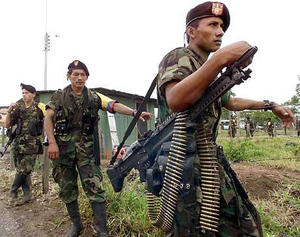For a number of years, I have sustained the thesis that one of the core reasons why the civil war in Colombia has endured for so long is because the costs of peace for the dominant classes and the United States is more than the costs of war. But it is still too early to assess what the costs of peace would entail because it largely depends on what the insurgents would ask in return for abandoning their 50-year armed struggle. Nor it is clear how far Colombian President Juan Manuel Santos is willing and capable of ceding to rebel demands. But I will venture in sketching some ideas that could help to assess the possibility of success in this process.
In the previous peace talks from 1998 through 2002, the FARC tested how far they could transform the power structure short of overthrowing the regime. Consequently, the dominant classes, broadly defined by two main factions—the economic conglomerates and the large landowning elite—felt their core class interests threatened. Alongside loomed the world hegemonic and imperial power: the United States, within which the decision makers and multinational companies could not stomach a leftist leaning regime in Bogotá joining the region’s winds of change undermining their political and economic interests. These forces combined to contribute to a decade of bloodshed, displacement, and dispossession of hundreds of thousands of peasants. The objectives of the war that began in 2002 were clear—either defeat the FARC or weaken its military and political power considerably in order to reduce its demands for peace, making it more affordable to the three aforementioned forces. The question then is: Are we there? How far are the FARC and its junior partner, the National Liberation Amy (ELN), willing to concede? Or is the United States willing to assume a benevolent stance toward an insurgency that throughout its history has been seeking a bourgeois revolution in the agrarian sector in which land property is democratized and activate the agrarian peasant economy. Would the United States help in making its multinational corporations operating in Colombia more accountable to the people and grant them the legitimate right to a better share of the profits while protecting the environment and stop funding the paramilitaries?

Colombia is at a crossroads. The insurgency and democratic forces could succeed once and for all in defeating the recalcitrant and reactionary landed elite that has distorted the capitalist development of the agrarian economy. Or the status quo will be upheld and millions of hectares of land previously used for food production to pastor land will contine to be transformed into hedge funds or tax shelters.
The calculus of the costs of this peace is complex and will require a convergence between opposing forces—the insurgency, the economic conglomerates, enlightened sectors of the urban bourgeoisie led by the Santos family, sectors of the military, and the United States. If this convergence happens, it may succeed where all previous attempts to modernize the agrarian economy from above have failed and where a more peaceful and prosperous Colombia lies. Each of the aforementioned groups will incur costs. The guerrillas are taking a risk where their political future is not guaranteed, but the continuation of this war has become too costly. The Colombian elite, multinational companies, sectors of the military, and the United States may have realized that the costs of this war have become unsustainable, averaging more than $10 billion a year in the defense budget of Colombia. Case in point, the proposed defense budget for 2013 is close to $14 billion (25.5 billion Colombian Pesos). This is as both the FARC and ELN have stepped up their military attacks against the oil and coal multinationals during the last seven months by 252% from the previous year causing the states to lose one million dollars in rent per day. This is without counting the costs of insurgent attacks on energy infrastructure, the total direct costs reach circa $400 million per year.
The military may have realized that the FARC and the ELN have improved their tactics and fighting capacity since 2008. This in turn was reflected in the success of the FARC in closing the gap in the ratio of fatalities reaching their lowest level since 2002 of 1:1.03 in favor of the military. This is an important indicator to a balance of power in the asymmetrical war happening in Colombia. This reduction in the fatality ratio is attributed to the FARC’s employment of guerrilla warfare tactics, snipers, and land mines laid out in its 2008 Plan of Rebirth. This has undoubtedly impacted the morale of the troops, leading to a conclusion that this war is not winnable and that the impressive expansion of the military has reached the point of diminishing returns. Santos, who served as former president Álvaro Uribe's defense Minister, may have realized that the costs of continuing this war are not worth the political gain.
In conclusion, there is some hope that the war system in Colombia may have reached its breaking point in which the costs of peace for the contending parties are approximating the costs of war.
Nazih Richani is the Director of Latin American studies at Kean University. He blogs at nacla.org/blog/cuadernos-colombianos.

